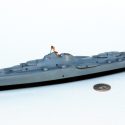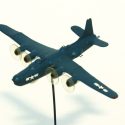
Consolidated PB4Y-2 “Privateer”
Craftsman: William Tompkins
Catalog #: 2014.6.66
Contributor: William Tompkins
A 1/600 scale model of the consolidated PB4Y-2 “Privateer” bomber aircraft.
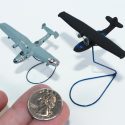
Consolidated PBY Catalina (PBY5-A, 1944)
Craftsman: William Tompkins
Catalog #: 2014.6.63
Contributor: William Tompkins
A 1/600 scale model of the consolidated PBY Catalina (PBY5-A, 1944) aircraft built by William Tompkins.
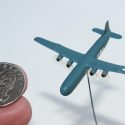
Consolidated Vultee XRSC-1
Craftsman: William Tompkins
Catalog #: 2014.6.65
Contributor: William Tompkins
A 1/600 scale model of the consolidated Vultee XRSC-1 transport aircraft.

Curtiss NC-4 Flying Boat (1919)
Craftsman: William Tompkins
Catalog #: 2014.6.69
Contributor: William Tompkins
A 1/600 scale model of the Curtiss NC-4 flying boat (1919).
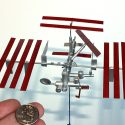
International Space Station
Craftsman: William Tompkins
Catalog #: 2014.6.70
Contributor: William Tompkins
Mr. Tompkins’ 1/600 scale model of the International Space Station.

Martin Mariner PBM-3 (1943)
Craftsman: William Tompkins
Catalog #: 2014.6.62
Contributor: William Tompkins
A 1/600 scale model of the Martin Mariner PBM-3 (1943) aircraft built by William Tompkins.

Naval Aircraft Factory NAF-TE (1921)
Craftsman: William Tompkins
Catalog #: 2014.6.68
Contributor: William Tompkins
A 1/600 scale model of the Naval Aircraft Factory NAF-TE airplane (1921).

Naval Galactic Carrier (SCB-44)
Craftsman: William Tompkins
Catalog #: 2014.6.73
Contributor: William Tompkins
A model of Bill’s Naval Galactic Carrier (SCB-44), which was an original design.

Naval Solar System Cruiser
Craftsman: William Tompkins
Catalog #: 2014.6.72
Contributor: William Tompkins
A 1/600 scale model of Bill’s Naval Solar System Cruiser prototype, which was an original design.
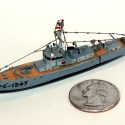
PC-450 (LS-154)
Craftsman: William Tompkins
Catalog #: 2014.6.55
Contributor: William Tompkins
A 1/600 scale model of PC-450 (LS-154), which was a submarine chaser.

Sikorsky HS-1 Flying Boat
Craftsman: William Tompkins
Catalog #: 2014.6.67
Contributor: William Tompkins
A 1/600 scale model of the Sikorsky HS-1 flying boat.
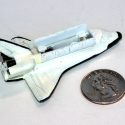
Space Shuttle
Craftsman: William Tompkins
Catalog #: 2014.6.71
Contributor: William Tompkins
A 1/600 scale model Space Shuttle built by William Tompkins.
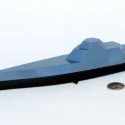
Stealth Cruiser (CCN-21, Designed 1969)
Craftsman: William Tompkins
Catalog #: 2014.6.17
Contributor: William Tompkins
Another design by Bill from 1969, this Stealth Cruiser accurately predicted the Zumwalt-class ships that were commissioned starting in 2014.

USS Acushnet (AT-63, 1908)
Craftsman: William Tompkins
Catalog #: 2014.6.57
Contributor: William Tompkins
A 1/600 scale model of USS Acushnet (AT-63, 1908), which was an ocean tug.
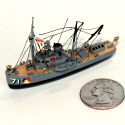
USS Albatross (AMC-71, 1944)
Craftsman: William Tompkins
Catalog #: 2014.6.46
Contributor: William Tompkins
A 1/600 scale model of USS Albatross (AMC-71, 1944), which was a minesweeper.
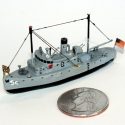
USS Bay Springs (AT-60, 1937)
Craftsman: William Tompkins
Catalog #: 2014.6.61
Contributor: William Tompkins
A 1/600 scale model of USS Bay Springs (AT-60, 1937), which was a fleet ocean tug.
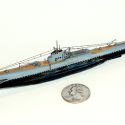
USS Bonita (SS-165, 1926)
Craftsman: William Tompkins
Catalog #: 2014.6.34
Contributor: William Tompkins
A 1/600 scale model of the submarine USS Bonita (SS-165, 1926).
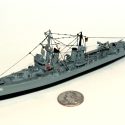
USS Case (DD-370, 1936)
Craftsman: William Tompkins
Catalog #: 2014.6.25
Contributor: William Tompkins
A 1/600 scale model of USS Case (DD-370, 1936), which was a destroyer.
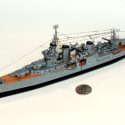
USS Colorado (BB-45, 1940)
Craftsman: William Tompkins
Catalog #: 2014.6.11
Contributor: William Tompkins
A 1/600 scale model of USS Colorado (BB-45, 1940) built by William Tompkins.
Showing 20 of 76 exhibits.

